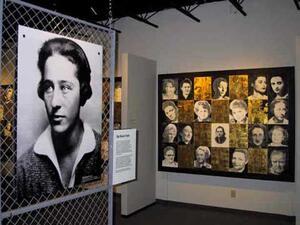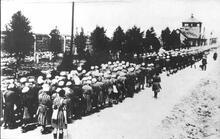Olga Benário Prestes
A Communist activist before and during World War II, Olga Benário Prestes first became involved in politics when she joined the Communist youth organization in Munich at age fifteen. Through her relationship with Communist leader Otto Braun, she was named a member of the Presidium of the Communist Youth International, the highest level in any Communist organization. She then became involved with the Brazilian Luis Carlos Prestes, and they traveled together to Brazil in 1934. Luis Carlos Prestes’ involvement in a failed Communist coup in Brazil led to Olga’s deportation to Germany. Once in Germany, she was first sent to Lichtenburg concentration camp and was eventually gassed at Bernburg in 1942, at the age of thirty-four.
Early Life and Communist Activities
Olga Benário Prestes would probably have chosen not to be included in an encyclopedia of Jewish women, since she was a Communist who was not a practicing Jew. She was born in Munich on February 12, 1908, to Eugenie and Leo Benário, a Jewish upper-middle-class Munich family. Her father, a Social Democrat and a volunteer attorney for poor factory workers, taught Olga to have concern for the poor and oppressed. More radical than her father, she joined the Communist youth organization in Munich at age fifteen.
After becoming romantically involved with Communist leader Otto Braun, she left home to carry out her revolutionary activities. In 1926, at the age of eighteen, she was imprisoned for the first time, together with Braun. She was released after three months of solitary confinement in Moabit Prison, and in April 1928 organized Braun’s jailbreak. She then fled with him to Moscow, where she was elected to the Central Committee of the Communist Youth International. She eventually broke off her relationship with Braun and was sent to Paris on a mission. When Olga returned to Moscow, she was given military training and named a member of the Presidium of the Communist Youth International, the highest level in any Communist organization.
In 1934, at the age of twenty-six, she was chosen by the Comintern to accompany Brazilian Communist leader Luis Carlos Prestes (1898–1990) to Brazil to help him in his revolutionary activities there. When his November 1935 revolution failed, she was captured and imprisoned in Rio de Janeiro. In the meantime, she and Prestes had fallen in love and she was pregnant. At the time of the Prestes revolution, Brazilian president Getúlio Vargas had a friendly relationship with the Hitler regime. To retaliate against Prestes, in September 1936 Vargas sent Olga back to Nazi Germany under armed guard. Upon her arrival in Germany in October, she was brought to the Berlin prison for women on Barnimstrasse, where her daughter, Anita, was born on November 27. At the age of fourteen months, the baby was miraculously rescued by her paternal grandmother.
Time in Concentration Camps
Olga was transferred to Lichtenburg in February 1938. In this medieval fortress that predated Ravensbrück as the main women’s concentration camp, Olga was placed in solitary confinement. She was sent on the first transport from Lichtenburg to Ravensbrück in the spring of 1939 and was a great heroine in both camps. She was assigned as a Blockalteste, in charge of an unruly group of women whom she organized and taught the necessity of personal hygiene.
Despite her own suffering, Olga carried out many acts that raised the women’s spirits and worked to better their conditions. She even made a small secret atlas to teach other prisoners about geography and the war, and this amazingly detailed atlas is today in the Ravensbrück archives. She also collaborated on a clandestine newspaper and helped to organize extra bread and margarine for women in the infirmary.
In addition to her other work assignments, she was a slave laborer for the Siemens electric company at Ravensbrück. In January 1940, along with seventy-nine other women, Olga was sent to the prison bunker, where she remained for thirty days. She had been among the six thousand prisoners kept in closed barracks for “security reasons” when Reichführer Heinrich Himmler visited the camp. Whipped almost to the verge of death, she nevertheless had to return to forced labor at the Siemens factory upon her release from the closed barracks.
At age thirty-four, Olga was among those Jewish political prisoners gassed at Bernburg in the winter and early spring of 1942. Her murder was part of the Nazis’ organized extermination, code-named “14f13.” The first selections in Ravensbrück began in December 1941 and January 1942, and the women selected were predominantly Jewish. Beginning in February 1942, they were sent to the Bernburg mental asylum, where they were killed in the gas chamber. An estimated fifteen hundred to sixteen hundred female prisoners were thus exterminated.
Legacy
Although Olga Benário Prestes is famous in Brazil and was considered a great heroine in the German Democratic Republic, her name is not well known in the United States. Her last act of spiritual resistance was a letter to her husband and daughter, which they received years afterward. Olga’s daughter, Anita Leocádia Prestes, is a historian living in Rio de Janeiro.
Olga Prestes’s story is part of a permanent memorial display of Jewish prisoners at Mahn-und Gedenkstätte Ravensbrück, the memorial on the site of the concentration camp.
Texts:
Buzzar, Rita de Cássia. “Olga.” In Não Olhe nos Olhos do Inimigo (Don’t Look in the Eyes of the Enemy). São Paulo: 1995, 17–31.
Loher, Dea. Olga’s Room. Translated by David Tushingham. Long: Oberon Books, 2013.
Morais, Fernando. Olga: Revolutionary and Martyr. New York: 1990.
Pontes, Matheus de Mesquita. “Luiz Carlos Prestes e Olga Benario: construções identitárias através da história e da literatura.” 2008.
Prestes, Anita Leocádia. “Olga Benário Prestes, minha mãe” (Olga Benário Prestes, my mother). In Não Olhe nos Olhos do Inimigo. São Paulo: 1995, 13–16.
Prestes, Anita Leocádia. Olga Benario Prestes: Uma comunista nos arquivos da Gestapo. São Paulo: Boltempo Editorial, 2017.
Prestes, Anita Leocádia. “Olga Benário Prestes e ‘a questão democrática.’” Germinal: Marxismo e Educação em Debate 12, no.1 (2020): 139-145.
Saidel, Rochelle. The Jewish Women of Ravensbrück Concentration Camp. Madison, Wisconsin: 2004.
Saidel, Rochelle. Women of Ravensbrück, Portraits of Courage: Art by Julia Terwilliger (exhibit and catalogue), The Florida Holocaust Museum, Saint Petersburg, 2001.
Strebel, Bernhard. “Ravensbrück: das zentrale Frauenkonzentrationslager.” In Die nationalsozialistischen Konzentrationslager. Entwicklung und Struktur, edited by Herbert Ulrich, Karin Orth, and Christoph Dieckmann Göttingen: 1998.
Von Freyberg, Jutta, and Ursula Krause-Schmitt. Moringen-Lichtenburg-Ravensbrück: Frauen im konzentrationslager, 1933–1945. Frankfurt: 1997, 133.
Werner, Ruth. Olga Benário: A Hístoria de uma Mulher Corajosa (History of a Courageous Woman). São Paulo: 1987.
Films and Other Media:
Olga Benario: Ein Leben für die Revolution, directed by Galip Iyitanir, Germany: 2004.
Olga, directed by Jayme Monjardim. Brazil: 2004.
Olga’s Room, composed by Jorge Antunes, Theatro Municipal of São Paulo, São Paulo, Brazil, October 14, 2006.




